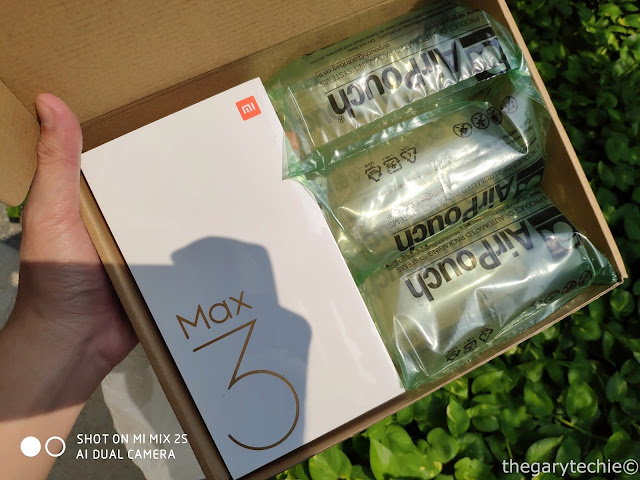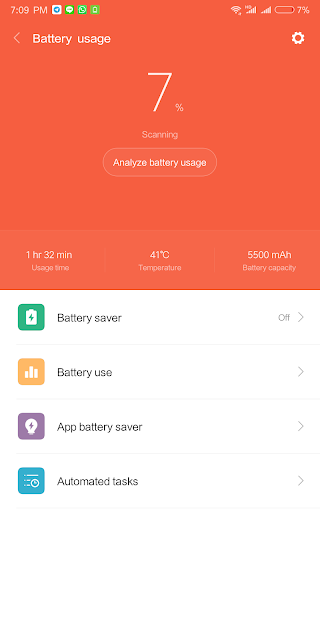Back in 2016, Xiaomi debuted their first MAX line-up as no other companies selling an giant phablet with giant 6" inches screen, massive battery size and performances. Which turns out to be popular in most markets. 2 years later, Xiaomi launched with their 3rd MAX line-up - Mi Max 3.
Let's get into the unboxing of Mi Max 3 - Just a little disappointed as Xiaomi did not included a soft casing this model. Unlike Xiaomi's entry level smartphone - Redmi 5 has a casing included :(

Long gone the capacitive buttons and the screen size goes fully immersive with 6.9' inch, 18:9 with 2160×1080. Both indoor and outdoor visibility under the sun are great. Personally will turn off the auto brightness and set it at a own preference range as the algorithm detects very awkwardly auto tuned.
Viewing multimedia on this gigantic screen is super impactful with the pairing of front-facing stereo speakers (as the earpiece section double as speaker) is very impressive.
In my experience, I do away the on-screen buttons and using the MIUI's gesture/swipe feature as much more efficient and making full use of screen real estate.
I was expecting Mi Max 3 has the Qualcomm Snapdragon 710 SoC rather it has the same SoC as Xiaomi Redmi Note 5's Snapdragon 636 instead. The Max 3 comes at two configuration - 64GB onboard storage and 4GB of RAM and 128GB with 6GB.
Battery capacity came at 5,500 MHA, a slight bump from Max 2's 5,300 MHA. During my usage, I can easily hit up to 7 hours of screen on time (SOT) with gaming, watching multimedia and doing some social media, and left estimate ~15% to last the whole day. So to an average user, it can last at most a couple of day without single charge. Max 3 does support Quick Charge 3.0 to refill your juice!
A pair of dual rear camera sensor was 12MP + 5MP with AI capability with identify object and scenery (available in the future software update). 8MP front facing the camera with AI selfie detection.
Videography are support at 4K, 1080p or 720p at 30fps and slow-mo 120fps at 720p. Generally the photos quality look decent in most shots but certain time some shots looks offset in terms of highlights. Camera sensors models are: nitrogen_s5k2l7_i , nitrogen_s5k5e8_i , nitrogen_s5k4h7_i
Here are some sample shots:
How much is tagged at?
64GB storage with 4GB RAM is priced at 1,699 yuan (~S$344) while the 128GB with 6GB RAM is 1,999 yuan (~S$405).
Verdict?
While comparing with Xiaomi's own line-up - Mi Pad 4 LTE version and it has no calling function and Max 3 checked all boxes of being a tablet and has better paper specs over Mi Pad 4 with an exclusion of comparison of SoC. I'll take this a tablet option as there are not many tablets to choose from and price to specification is acceptable.
Let's get into the unboxing of Mi Max 3 - Just a little disappointed as Xiaomi did not included a soft casing this model. Unlike Xiaomi's entry level smartphone - Redmi 5 has a casing included :(

Long gone the capacitive buttons and the screen size goes fully immersive with 6.9' inch, 18:9 with 2160×1080. Both indoor and outdoor visibility under the sun are great. Personally will turn off the auto brightness and set it at a own preference range as the algorithm detects very awkwardly auto tuned.
Viewing multimedia on this gigantic screen is super impactful with the pairing of front-facing stereo speakers (as the earpiece section double as speaker) is very impressive.
In my experience, I do away the on-screen buttons and using the MIUI's gesture/swipe feature as much more efficient and making full use of screen real estate.
I was expecting Mi Max 3 has the Qualcomm Snapdragon 710 SoC rather it has the same SoC as Xiaomi Redmi Note 5's Snapdragon 636 instead. The Max 3 comes at two configuration - 64GB onboard storage and 4GB of RAM and 128GB with 6GB.
Available in 3 colors - Gold, Black and Dark Blue (or Navy Blue).
Upgrade between Mi Max 2 (left) and Mi Max 3 (right)
Battery capacity came at 5,500 MHA, a slight bump from Max 2's 5,300 MHA. During my usage, I can easily hit up to 7 hours of screen on time (SOT) with gaming, watching multimedia and doing some social media, and left estimate ~15% to last the whole day. So to an average user, it can last at most a couple of day without single charge. Max 3 does support Quick Charge 3.0 to refill your juice!
A pair of dual rear camera sensor was 12MP + 5MP with AI capability with identify object and scenery (available in the future software update). 8MP front facing the camera with AI selfie detection.
Videography are support at 4K, 1080p or 720p at 30fps and slow-mo 120fps at 720p. Generally the photos quality look decent in most shots but certain time some shots looks offset in terms of highlights. Camera sensors models are: nitrogen_s5k2l7_i , nitrogen_s5k5e8_i , nitrogen_s5k4h7_i
Here are some sample shots:
How much is tagged at?
64GB storage with 4GB RAM is priced at 1,699 yuan (~S$344) while the 128GB with 6GB RAM is 1,999 yuan (~S$405).
Verdict?
While comparing with Xiaomi's own line-up - Mi Pad 4 LTE version and it has no calling function and Max 3 checked all boxes of being a tablet and has better paper specs over Mi Pad 4 with an exclusion of comparison of SoC. I'll take this a tablet option as there are not many tablets to choose from and price to specification is acceptable.





















